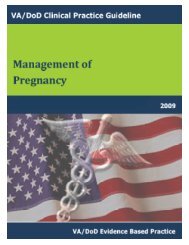DM Full Guideline (2010) - VA/DoD Clinical Practice Guidelines Home
DM Full Guideline (2010) - VA/DoD Clinical Practice Guidelines Home
DM Full Guideline (2010) - VA/DoD Clinical Practice Guidelines Home
You also want an ePaper? Increase the reach of your titles
YUMPU automatically turns print PDFs into web optimized ePapers that Google loves.
Version 4.0<br />
<strong>VA</strong>/<strong>DoD</strong> <strong>Clinical</strong> <strong>Practice</strong> <strong>Guideline</strong><br />
for the Management of Diabetes Mellitus<br />
APPENDIX G-1<br />
Measurements of Glycemic Control<br />
The correlation between tests of glycemic control and HbA 1 c, even using the National Glycosylated<br />
Standardization Program reference standard, may differ by methodology, age, race, and by comorbid<br />
conditions.<br />
o<br />
o<br />
o<br />
Certain HbA 1 c measurements may also be unreliable in the presence of the following conditions:<br />
hemolytic anemia, uremia, chronic kidney disease or pregnancy.<br />
HbA 1 c is higher for a given level of glycemic control in older individuals and minority patients than<br />
in Caucasians.<br />
The measurement of HbA 1 c is subject to red cell survival, and the composition of red cell hemoglobin<br />
Measurements of Glycemic Control<br />
1. For long-term glycemic control (past 3 months), HbA 1 c is the preferred method unless the patient has a<br />
clinical condition (acute blood loss, iron deficiency anemia, significant chronic renal insufficiency, severe<br />
anemia.)<br />
2. <strong>Clinical</strong> laboratories should use methodologies that are certified to the National Glycosylated<br />
Standardization Program (NGSP; ngsp.org). However, even use of certified assays does not mean that a<br />
laboratory result is directly comparable to the NGSP reference standard, or that there is no interference<br />
from hemoglobinopathies.<br />
3. Relative to the DCCT standard, some methods (such as HPLC) tend to overestimate, while immunoassays<br />
tend to underestimate true A1c values (“bias”).<br />
4. Clinicians should recognize that any HbA 1 c value from any laboratory has measurement error associated<br />
with it (the intra-assay coefficient of variation). In order to achieve National Glycosylated Standardization<br />
Program certification an HbA 1 c value must be within ±8% of the referent standard in <strong>2010</strong>, and ±6% in<br />
2011. This has implications for the way HbA 1 c levels are interpreted as to whether a patient has or has not<br />
achieved their glycemic control target. As an example, an HbA 1 c value of 7% could vary by up to 0.5%<br />
within the same assay. The National Glycosylated Standardardization Program web site should be accessed<br />
for the most up-to-date information (ngsp.org).<br />
5. Target values for glycemic control do not have to be a whole number since HbA 1 c is a continuous risk<br />
factor. It should be understood that achieving the goals must not occur at the expense of safety; that small<br />
differences from goal may not have significant impact upon absolute risk reduction of complications. Also,<br />
goals can and should be modified (upward or downward) as clinical circumstances or patient preferences<br />
warrant.<br />
6. Point of Care (POC) HbA 1 c methodologies are available. However, in June 2009 the National<br />
Glycosylation Standardization Program noted the following: “There was much concern regarding the lack<br />
of data on POC methods, the fact that these methods are CLIA-waived means that users of the methods are<br />
not required to participate in the CAP survey. Nonetheless these methods are widely used, especially in the<br />
developing world, and therefore it is important to know how well they are performing in the field.” Local<br />
facilities should develop their own policies for supervision of POC in practice and inform clinicians of the<br />
likely variance between these test results and those obtained in the clinical laboratory. This information<br />
needs to be communicated to clinicians using the tests.<br />
Glucose Measurements<br />
• Single point measurement of blood sugar can be determined from venous samples and capillary glucose<br />
measurements. Only venous samples should be used for the diagnosis of <strong>DM</strong>. Capillary blood sugar measures<br />
can be used for home monitoring.<br />
• The most common user error associated with self-managed blood glucose (SMBG) is inadequate sample size.<br />
Depending upon the meter used, this error can lead to a significant discrepancy between the actual and recorded<br />
blood glucose. A user's technique and maintenance procedures should be reviewed annually or as indicated.<br />
Module G: Glycemic Control: Appendices Page 78
















